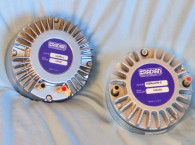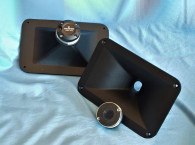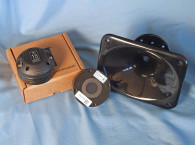




Radian Audio Engineering, Inc. was founded in 1988 by its president, Dr. Richard Kontrimas, with the mission of manufacturing great sounding, high-quality loudspeakers at affordable prices. Radian’s initial offerings were replacement compression driver diaphragms. The diaphragms were so successful that it wasn’t long before the company was making compression drivers. Several major loudspeaker manufacturers quickly identified Radian as an important source for their compression driver needs and became OEM customers. Coaxial loudspeakers were introduced shortly thereafter, followed by woofers and finally, complete loudspeaker systems.
Today, Radian Audio, based in Orange, CA, is a serious player in the OEM loudspeaker component business, the sound contractor/fixed installation market, and the portable/tour sound industry. With more than two decades of success under its belt, Radian is well into its third decade as a pro sound manufacturer and is introducing new pro sound transducers such as the LT6 pro sound ribbon.
Voice Coil has featured several of Radian’s neodymium series of compression drivers, including the 960PB and the 950PB 2” exit aluminum diaphragm compression drivers (in the November 2014 issue), and the 745NEO with both the aluminum and beryllium diaphragms (in the October 2017 issue). This month, Radian sent the 951PB, a 1.4” exit version of the previously featured 950PB.
As you would expect, the 950PB and the 951PB compression drivers share almost identical feature sets. Both have neodymium ring magnet motors, high temperature 101.6 mm (4”) diameter polyimide voice coil formers wound with copper-clad aluminum-edge wound ribbon wire voice coils, 125 W continuous power handing (250 W program power handing), a self-aligning field-replaceable diaphragm assembly, and the most important feature, a proprietary processed and hardened aerospace-grade aluminum alloy diaphragm. Since Radian does not produce horns for its compression drivers, I coupled it with B&C Speakers’ ME90 cast-aluminum constant directivity 80° × 60° 1.4” exit horn. For a compression driver, the 951PB weighs a substantial 10.4 lb. (see Photo 1).




I began testing the Radian 951PB/B&C Speakers ME90 combination using the LinearX LMS analyzer to produce the 300-point stepped sine wave impedance plot shown in Figure 1. The solid black curve represents the Radian 951PB mounted on the ME90 horn and the dashed blue curve represents the compression driver without the horn. With a 5.02 Ω DCR (Re), the minimum impedance of the 951PB/ ME90 was 5.4 Ω and at 2.5 kHz.
For the next set of SPL measurements, I free-air mounted the 951PB/ME90 combination without an enclosure and measured both the horizontal and the vertical on- and off-axis at 2.83 V/1 m, again using the LMS gated sine wave sweeps to product both horizontal and vertical plane SPL data from 0° on-axis to 60° off-axis (note the new LOUDSOFT 192 kHz FINE R+D analyzer will be arriving in time for the next issue and I will use it to provide SPL measurements for Test Bench).
Figure 2 illustrates the on-axis frequency response of the 951PB/ME90 combination, which is smooth with no major anomalies plus a declining response as frequency increases above 2.0 kHz, and extending to somewhat beyond 20 kHz, requiring the usual constant directivity horn equalization. Two breakup modes occur at 13.5 kHz and 19 kHz.
Figure 3 depicts the on- and off-axis (0° to 60°) response in the horizontal plane. Figure 4 displays the normalized horizontal plane response. Figure 5 shows the CLIO Pocket analyzer’s generated 180° horizontal polar plot (in 10° increments with 1/3 octave smoothing applied). Figure 6 gives the on- and off-axis to 60° response in the vertical plane. Figure 7 depicts the normalized vertical plane response.
Figure 8 provides the CLIO Pocket-generated vertical plane polar plot (in 10° increments with 1/3 octave smoothing applied). Last, Figure 9 illustrates the two-sample SPL comparison showing the two Radian 951PB compression drivers within less than 1 dB throughout the operating range to 10 kHz of the transducer.




I set up the Listen, Inc. AudioConnect analyzer, the SoundCheck 16 software, and the Listen 1/4” SCM microphone (courtesy of Listen, Inc.) to measure distortion and generate time-frequency plots. For the distortion measurement, I mounted the 951PB/ME90 combination in free-air in the same manner as was used for the frequency response measurements, and set the SPL to 104 dB at 1 m (2.37 V determined by using a pink noise stimulus generator and the internal SLM in the SoundCheck 16 software).
Then, I measured the distortion with the Listen 1/4” measurement microphone located 10 cm from the mouth of the horn. This produced the distortion curves shown in Figure 10 (red curve = second harmonic, blue curve = third harmonic).
Following this test sequence, I then set up SoundCheck 16 to generate a 2.83 V/1 m impulse response for the 951PB/ME90 combination and imported the data into Listen’s SoundMap Time/Frequency software. Figure 11 shows the resulting cumulative spectral decay (CSD) waterfall plot. Figure 12 shows the Short Time Fourier Transform (STFT) plot.
I almost never have any subjective experience with the transducers that I characterize in Voice Coil’s Test Bench, however thanks to Radian’s generosity, the 2” 950PB samples ended up in a far-field monitor that I designed for my home recording studio. The cabinets were built by my friend and Triad chief engineer David Nelson, and the system utilizes a B&C Speakers 15BG100 15” neodymium motor woofer with a NBR surround, an 18 Sound XR2064C 60° × 40° 2” throat cast-aluminum horn, and a high-performance passive network that included Goertz foil inductors, Jantzen capacitors, and Mundorf M-Resist resistors. Subjectively, this speaker is incredibly musical, detailed, and extremely easy to listen to — certainly a goal for all monitors.
The 951PB 1.4” compression driver displays excellent performance for a high power handling package, and a neodymium motor compression driver build quality that is pretty much as good as it gets. For more information, contact Radian Audio Engineering Inc., 600 N. Batavia St., Orange, CA 92868, Phone: 714-288-8900, Fax: 714-288-1133, E-mail, or visit www.radianaudio.com.
This article was originally published in Voice Coil, July 2018.







